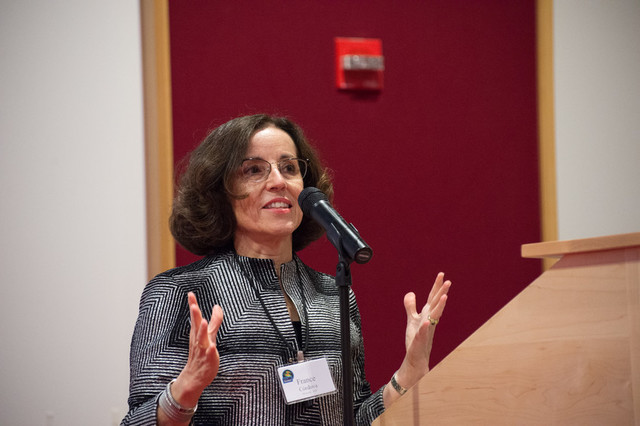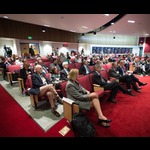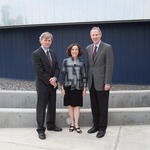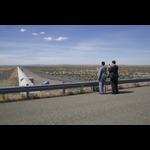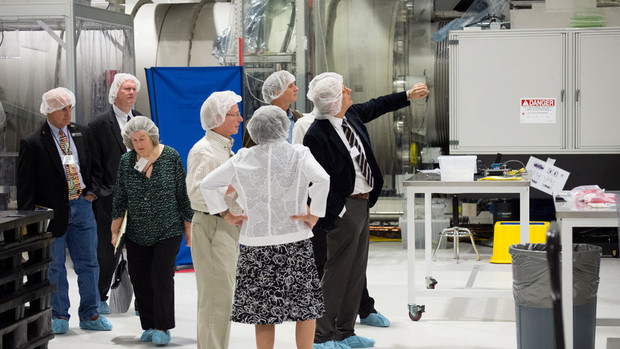
Attendees of the Advanced LIGO dedication event enjoy a tour of the LIGO Hanford interferometer. (Photo: Kim Fetrow)
Finding Einstein: Dedicating the Advanced LIGO Detectors
News Release • May 19, 2015
LIGO was designed and is operated by Caltech and MIT, with funding from the National Science Foundation (NSF). Advanced LIGO, also funded by the NSF, will begin its first searches for gravitational waves in the fall of this year.
The Advanced LIGO Project, a major upgrade that will increase the sensitivity of the Laser Interferometer Gravitational-wave Observatories instruments by a factor of 10 and provide a 1,000-fold increase in the number of astrophysical candidates for gravitational wave signals, was officially dedicated today in a ceremony held at the LIGO Hanford facility in Richland, Washington.
LIGO was designed and is operated by Caltech and MIT, with funding from the National Science Foundation (NSF). Advanced LIGO, also funded by the NSF, will begin its first searches for gravitational waves in the fall of this year.
- See more at: http://www.caltech.edu/news/dedication-advanced-ligo-46822#sthash.4mWO7mRf.dpufMay 19th 2015 was a day to remember for all those involved with LIGO, and especially those who have spent the last five or many more years of their lives working on upgrading this remarkable instrument with their very own hands. On this day, the Advanced LIGO detectors were officially declared complete and dedicated in a ceremony held at LIGO Hanford Observatory in Richland, Washington.
Over 100 staff, faculty, researchers, and dignitaries of all kinds were on hand to congratulate Caltech and MIT on the completion of the upgraded gravitational wave detectors and celebrate such a monumental accomplishment. Included in the upgrade were changes in the lasers, optics, seismic isolation systems, and in how the microscopic motion of the test masses is detected.
The resulting Advanced LIGO detectors are 10 times more sensitive than Initial LIGO, and subsequently able to probe 1000 times more volume of space and gravitational-wave generating objects contained within that space. Eventually, LIGO will also search for the gravitational cosmic background—allowing tests of theories about the development of the universe only 10-35 seconds after the Big Bang.
Among those attending the dedication were Caltech president Dr. Thomas F. Rosenbaum, NSF director Dr. France Córdova, MIT Vice President Dr. Kirk Kolenbrander, and Dr. Jackie Hewitt, Director of the Kavli Institute for Astrophysics and Space Research at MIT.
"Advanced LIGO represents a critically important step forward in our continuing effort to understand the extraordinary mysteries of our universe," said Córdova. "It gives scientists a highly sophisticated instrument for detecting gravitational waves, which we believe carry with them information about their dynamic origins and about the nature of gravity that cannot be obtained by conventional astronomical tools."
LIGO’s executive director, David Reitze, praised all of LIGO’s staff, adding,
"We've spent the past seven years putting together the most sensitive gravitational-wave detector ever built. Commissioning the detectors has gone extremely well thus far, and we are looking forward to our first science run with Advanced LIGO beginning later in 2015. This is a very exciting time for the field."
And in his address to attendees, David Shoemaker of MIT, the project leader for Advanced LIGO stated,
"To achieve this improvement, we took many lessons learned from initial LIGO, put them together with the results of world-wide R&D, and made a complete re-design and replacement of the detectors."
LIGO’s first science run with the advanced LIGO instruments will commence on September 14, 2015. For more information on that, read “The countdown to detection has begun”.
LIGO was designed and is operated by Caltech and MIT, with funding from the National Science Foundation (NSF). Advanced LIGO, also funded by the NSF, will begin its first searches for gravitational waves on September 14th, 2015.
(Written with content from Kathy Svitil, Director of News, Caltech News Office)
redicted by Albert Einstein in 1916 as a consequence of his general theory of relativity, gravitational waves are ripples in the fabric of space and time produced by violent events in the distant universe—for example, by the collision of two black holes or by the cores of supernova explosions. Gravitational waves are emitted by accelerating masses much in the same way as radio waves are produced by accelerating charges, such as electrons in antennas. As they travel to Earth, these ripples in the space-time fabric bring with them information about their violent origins and about the nature of gravity that cannot be obtained by other astronomical tools - See more at: http://www.caltech.edu/news/dedication-advanced-ligo-46822#sthash.ke3tnPW6.dpufMay 19th 2015 was a day to remember for all those involved with LIGO, and especially those who have spent the last five or many more years of their lives working on upgrading this remarkable instrument with their very own hands. On this day, the Advanced LIGO detectors were officially declared complete and dedicated in a ceremony held at LIGO Hanford Observatory in Richland, Washington.
Over 100 staff, faculty, researchers, and dignitaries of all kinds were on hand to congratulate Caltech and MIT on the completion of the upgraded gravitational wave detectors and celebrate such a monumental accomplishment. The upgrade included changes to LIGO's lasers, optics, seismic isolation systems, and to how the microscopic motion of the test masses is detected.
The resulting Advanced LIGO detectors are 10 times more sensitive than Initial LIGO, and subsequently able to probe 1000 times more volume of space and gravitational-wave generating objects contained within that space. Eventually, LIGO will also search for the gravitational cosmic background—allowing tests of theories about the development of the universe only 10-35 seconds after the Big Bang.
Among those attending the dedication were Caltech president Dr. Thomas F. Rosenbaum, NSF director Dr. France Córdova, MIT Vice President Dr. Kirk Kolenbrander, and Dr. Jackie Hewitt, Director of the Kavli Institute for Astrophysics and Space Research at MIT. In addition, Washington State Representatives the Hon. Brad Klippert and the Hon. Larry Haler were also in attendance. Kelly Ogilvie, Senior Policy Advisor for the Office of Governor Jay Inslee and representatives for Senator Maria Cantwell and Congressman Dan Newhouse were also present.
NSF Director, Dr. France Cordova speaks to attendees of the Advanced LIGO dedication event. (Photo: Kim Fetrow)
"Advanced LIGO represents a critically important step forward in our continuing effort to understand the extraordinary mysteries of our universe," said Córdova. "It gives scientists a highly sophisticated instrument for detecting gravitational waves, which we believe carry with them information about their dynamic origins and about the nature of gravity that cannot be obtained by conventional astronomical tools."
LIGO’s executive director, David Reitze, praised all of LIGO’s staff, adding,
"We've spent the past seven years putting together the most sensitive gravitational-wave detector ever built. Commissioning the detectors has gone extremely well thus far, and we are looking forward to our first science run with Advanced LIGO beginning later in 2015. This is a very exciting time for the field."
And in his address to attendees, David Shoemaker of MIT, the project leader for Advanced LIGO stated,
"To achieve this improvement, we took many lessons learned from initial LIGO, put them together with the results of world-wide R&D, and made a complete re-design and replacement of the detectors."
LIGO’s first science run with the advanced LIGO instruments will commence on September 14, 2015. For more information on that, read “The countdown to first observations has begun”.
LIGO was designed and is operated by Caltech and MIT, with funding from the National Science Foundation (NSF). Advanced LIGO, also funded by the NSF, will begin its first searches for gravitational waves on September 14th, 2015.
Written by Kimberly M. Burtnyk, with content from Kathy Svitil, Director of News, Caltech News Office

